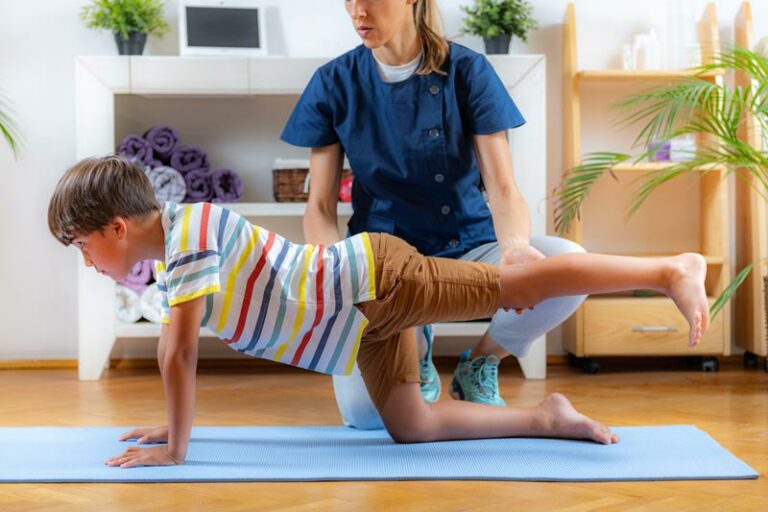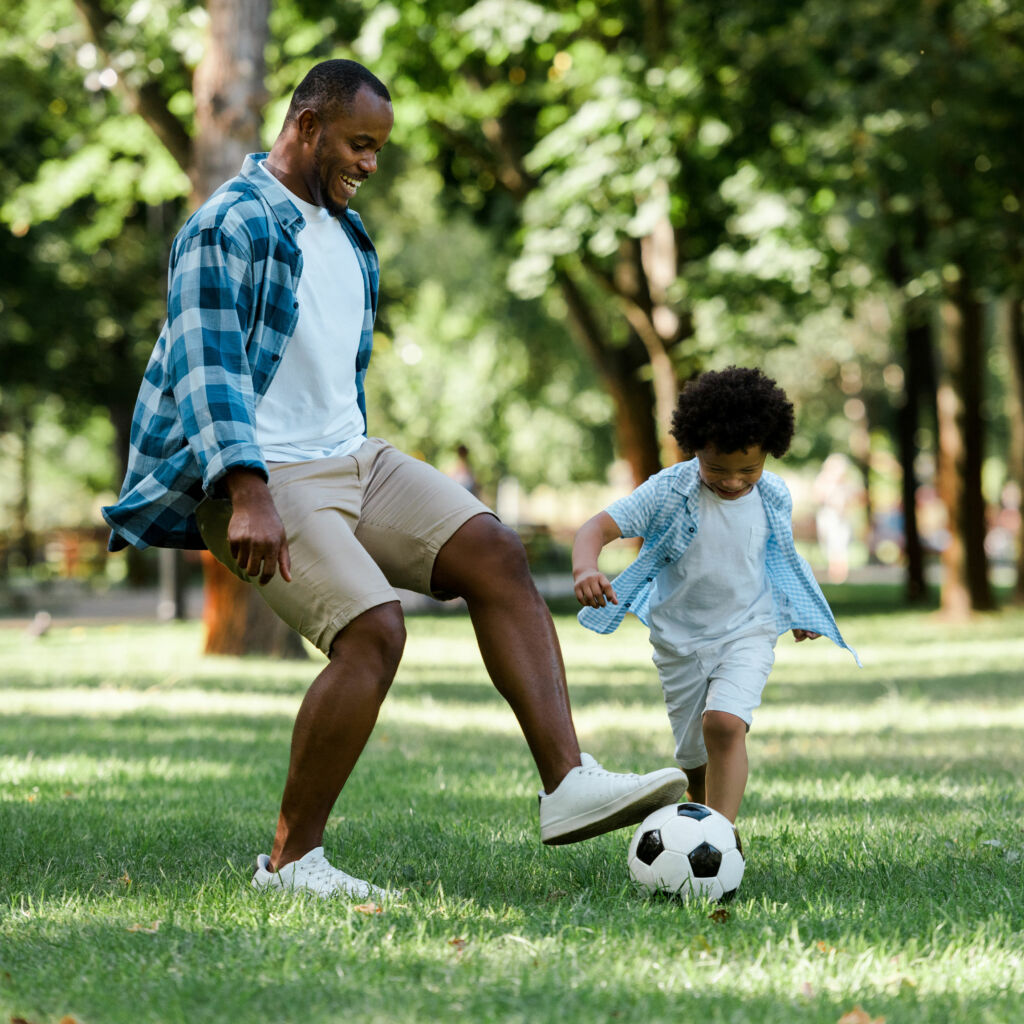Our increasingly sedentary lifestyle — which can certainly be attributed at least in part to technological advances — poses health risks that we are all essentially aware of as adults. We know we should be more active and many of us regularly set goals to increase our physical activity. But what exactly does that mean?
Physical Activity – the What and the Why
Physical activity is “voluntary, self-directed, and purposeful exploration and play.”1
Increased physical activity has been shown to help prevent and manage illnesses such as heart disease, stroke, cancer, diabetes, obesity, and hypertension. Regular physical activity is also tied to improved mental health and overall quality of life.
While these conditions are generally associated with aging or older adults, staying active is just as important for children, if not more so. Did you know that physical activity in kids can help other domains of development flourish?
The more independence for self-exploration of their environment that young children have, the more social interaction they have. Furthermore, a high level of physical activity in children increases cognitive performance.
The Centers for Disease Control (CDC) and the World Health Organization (WHO) offer the following guidelines for physical activity for children without disabilities:
- Muscle and bone strengthening for 60 minutes at least 3 times per week
- Children 1-4 should have a total of 180 minutes (about 3 hours) of physical activity, of which 60 minutes is moderate to vigorous
- Children 5-17 60 minutes of moderate to vigorous exercise daily, with vigorous exercise 3 times per week

Unfortunately, there are undeniable disparities in the accessibility of physical activity for families and children. Due to environmental factors and/or disability, not everyone has access to outlets for functional fitness. Additionally, sometimes children do not feel included or do not feel comfortable or like they belong in the options available to them, such as in P.E. classes at school.
These sentiments of not belonging can diminish a child’s eagerness to participate in fitness-based activities. They are less likely to enjoy movement, which could limit motivation to engage in physical activity at all.
How do the social determinants of health (SDOH) impact physical activity?
The social determinants of health (SDOH), defined by the CDC as nonmedical factors that influence health outcomes, play a significant role in people’s opportunities. The economic, social and environmental conditions in which a family lives can influence participation in physical activity and sedentary behaviors in adults and children.
For example, those who live in urban areas may not have access to safe places to walk outside or to public green areas such as parks. Families in a low socioeconomic situation may not have the financial means or time to put toward organized sports.

Furthermore, some children may have difficulty coordinating movement patterns, making physical activity more challenging for them.
This difference between peers can be isolating and decrease self-confidence, especially when kids are expected to do things such as run a mile in a certain time but may not have the physical cardiovascular capacity, motor planning, or exposure to training to do so.
Another example is the lack of accessible parks and playgrounds in existence for people with disabilities.
Lastly, knowledge of adaptive sport/activity resources is limited, and few community resources provide these services.
Fitness for all – insight and tips for making movement fun!
It can be challenging to overcome obstacles to physical activity, but there are ways to stay active no matter what your situation is.
As a parent or caregiver, recognize that there is power in being an active role model! Then, spend time focusing on ways you can motivate and support the kids in your life as they learn to enjoy new activities and embrace physical activity as a way to have fun. Commit to the following:
- Encourage upright self-mobility in children with disabilities, especially at young ages (infancy through pre-school age).
- Adapted ride-on toys are available for kids who can’t move in the traditional ways we typically think and feel movement should look. Check out GoBabyGo!
- Find adaptive sports teams or programs in your area for kids with disabilities.
- Focus on the fun in physical activities, decrease competitiveness of sports and emphasize self-growth all while promoting fitness for life!
- Find ways to be active as a family! Regardless of SDOH, there are many ways to incorporate movement:
- Get outside for a walk, a scavenger hunt, or a game of follow-the-leader.
- Find accessible indoor play spaces to tumble, swim, skate or play an indoor sport.
- Stay home and have a dance party, a hula hooping contest, or an obstacle course challenge, which can be made with household items such as pillows, step stools, masking tape to make patterns on the floor, or sidewalk chalk for sunny days to draw courses outside.
Want more ideas? Check out our blog: 5 Simple Ideas to Keep Kids Active Over the Holidays!
Reach your family fitness goals through physical therapy.
Physical therapists are passionate about helping people maximize their movement to ensure they can engage in regular physical activity that supports their health and well-being. As a pediatric PT, I am particularly driven to encourage lifelong fitness in children beginning at a young age and to provide my community with resources that make fitness fun and accessible for all.
These goals are reinforced in the mission and vision of the American Physical Therapy Association (APTA), our profession’s national organization.
- APTA vision statement: Transforming society by optimizing movement to improve the human experience.
- APTA mission statement: Building a community that advances the profession of physical therapy to improve the health of society.
Furthermore, the APTA code of ethics implores physical therapists to “participate in efforts to meet the health needs of people locally, nationally, or globally” by advocating “to reduce health disparities and health care inequities, improve access to health care services, and address the health, wellness, and preventive health care needs of people.”
Knowing when to seek the care of a physical therapist can seem tricky, but as musculoskeletal experts, we are uniquely qualified to assess movement and identify dysfunction in people of all ages and abilities.
It is a common myth that you have to be hurt or recovering from a major injury or surgery to benefit from PT. In fact, physical therapy can be helpful if you have any challenges with functional motor skills, coordination, balance, strength, flexibility, mobility or a wide range of other conditions.

When it comes to your child, you know them best. If you notice your child falling behind peers consistently, if their teachers at school report observing your child struggling to keep up with peers on the playground or in P.E., or if you are worried about your child moving toward unhealthy lifestyle habits, reach out! We would be honored to help you determine the root cause of the problem and under direct access law, you can seek the care of a physical therapist without a prescription or referral.
However, as mentioned previously, you know your child best. So, advocate for them, and encourage them to move in a way that feels good for them. If you would like assistance, know that physical therapists can help provide insight on activities that may work for them based on how their body moves. They can also provide ways to improve confidence in movement and play. As a pediatric physical therapist, it is my goal to help provide appreciation for safe, functional, meaningful movement to help children participate with family and friends in fun physical activity.
Resources:
- https://www.frontiersin.org/articles/10.3389/fpubh.2016.00204/full#B7
- https://www.cdc.gov/physicalactivity/basics/pa-health/index.htm
- https://www.cdc.gov/healthyschools/physicalactivity/facts.htm
- https://www.apta.org/apta-and-you/leadership-and-governance/policies/code-of-ethics-for-the-physical-therapist

Youth orthopedic PT.
Youth orthopedic physical therapy focuses on improving gross and fine motor skills, mobility, balance and coordination, strength and endurance, and cognitive and sensory processing and integration. Our specialized physical therapists will work with you to address your child’s unique needs in a fun and supportive environment.

